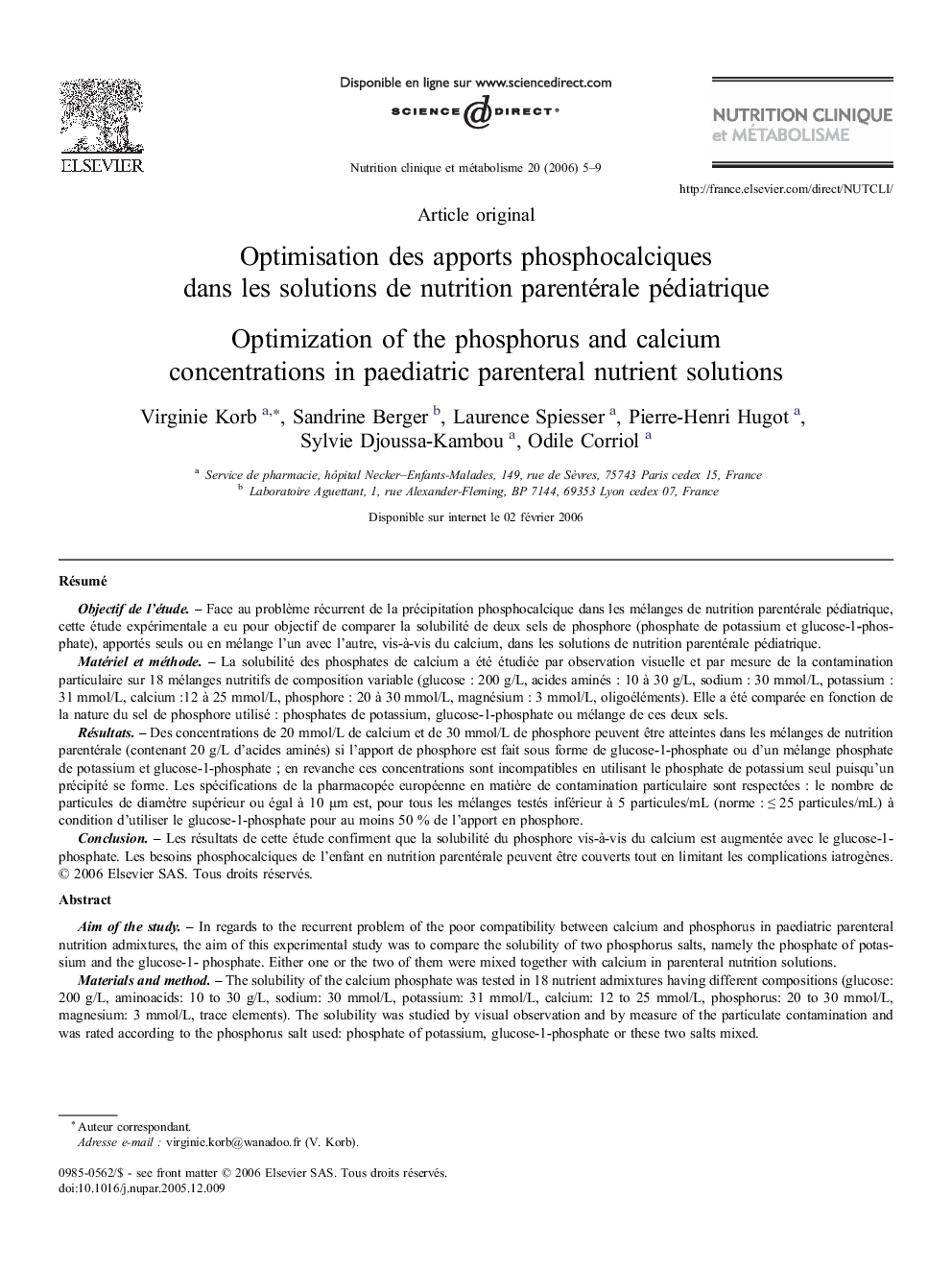| Article ID | Journal | Published Year | Pages | File Type |
|---|---|---|---|---|
| 2693241 | Nutrition Clinique et Métabolisme | 2006 | 5 Pages |
RésuméObjectif de l'étude. – Face au problème récurrent de la précipitation phosphocalcique dans les mélanges de nutrition parentérale pédiatrique, cette étude expérimentale a eu pour objectif de comparer la solubilité de deux sels de phosphore (phosphate de potassium et glucose-1-phosphate), apportés seuls ou en mélange l'un avec l'autre, vis-à-vis du calcium, dans les solutions de nutrition parentérale pédiatrique.Matériel et méthode. – La solubilité des phosphates de calcium a été étudiée par observation visuelle et par mesure de la contamination particulaire sur 18 mélanges nutritifs de composition variable (glucose : 200 g/L, acides aminés : 10 à 30 g/L, sodium : 30 mmol/L, potassium : 31 mmol/L, calcium :12 à 25 mmol/L, phosphore : 20 à 30 mmol/L, magnésium : 3 mmol/L, oligoéléments). Elle a été comparée en fonction de la nature du sel de phosphore utilisé : phosphates de potassium, glucose-1-phosphate ou mélange de ces deux sels.Résultats. – Des concentrations de 20 mmol/L de calcium et de 30 mmol/L de phosphore peuvent être atteintes dans les mélanges de nutrition parentérale (contenant 20 g/L d'acides aminés) si l'apport de phosphore est fait sous forme de glucose-1-phosphate ou d'un mélange phosphate de potassium et glucose-1-phosphate ; en revanche ces concentrations sont incompatibles en utilisant le phosphate de potassium seul puisqu'un précipité se forme. Les spécifications de la pharmacopée européenne en matière de contamination particulaire sont respectées : le nombre de particules de diamètre supérieur ou égal à 10 μm est, pour tous les mélanges testés inférieur à 5 particules/mL (norme : ≤ 25 particules/mL) à condition d'utiliser le glucose-1-phosphate pour au moins 50 % de l'apport en phosphore.Conclusion. – Les résultats de cette étude confirment que la solubilité du phosphore vis-à-vis du calcium est augmentée avec le glucose-1-phosphate. Les besoins phosphocalciques de l'enfant en nutrition parentérale peuvent être couverts tout en limitant les complications iatrogènes.
Aim of the study. – In regards to the recurrent problem of the poor compatibility between calcium and phosphorus in paediatric parenteral nutrition admixtures, the aim of this experimental study was to compare the solubility of two phosphorus salts, namely the phosphate of potassium and the glucose-1- phosphate. Either one or the two of them were mixed together with calcium in parenteral nutrition solutions.Materials and method. – The solubility of the calcium phosphate was tested in 18 nutrient admixtures having different compositions (glucose: 200 g/L, aminoacids: 10 to 30 g/L, sodium: 30 mmol/L, potassium: 31 mmol/L, calcium: 12 to 25 mmol/L, phosphorus: 20 to 30 mmol/L, magnesium: 3 mmol/L, trace elements). The solubility was studied by visual observation and by measure of the particulate contamination and was rated according to the phosphorus salt used: phosphate of potassium, glucose-1-phosphate or these two salts mixed.Results. – Concentrations of 20 mmol of calcium and 30 mmol of phosphorus can be obtained in parenteral nutrition admixtures (containing 2% of amino acids) if the initial input of phosphorus is of the form of the GP. On the other hand, these concentrations are incompatible when using the phosphate of potassium because a precipitate occurs.The specifications of the european pharmacopeia are respected: for the particulate contamination, the number of particles with a diameter ≥ 10 μm is for all the tested admixtures lower than 5 particles/ml (standard: ≤ 25 particles/ml) if the GP represents at least 50% of the initial phosphorus input.Conclusion. – The results of this study confirm that the solubility of the phosphorus regarding to calcium is increased with the glucose-1-phosphate.The calcium and phosphorus needs for the children in parenteral nutrition can be covered while limiting the iatrogenic complications.
